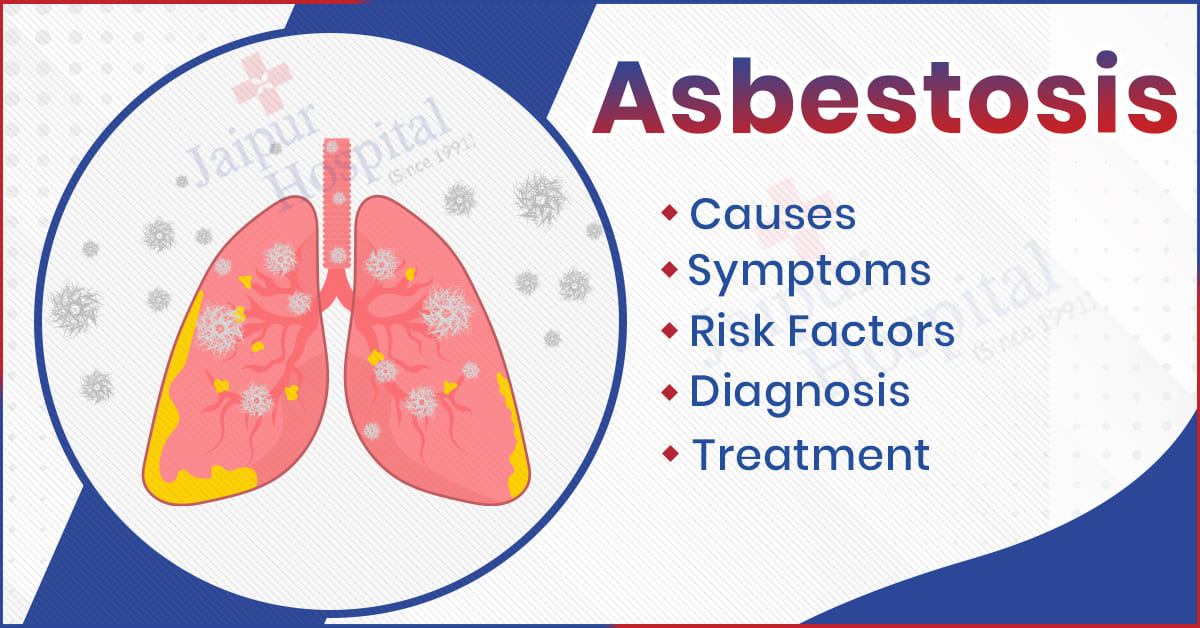Introduction
Asbestosis is an irreversible pulmonic pathology that results from prolonged exposure to asbestos fibres and involves lung fibrosis and respiratory difficulties. Mainly affected are workers in the asbestos-charged industries.
Knowledge of Asbestosis is of utmost importance since it greatly diminishes lung capacity and general respiratory well-being. The present paper is to elaborate on the etiology of Asbestosis, its symptoms, risk factors, diagnosis, and treatment options. It aims to provide a comprehensive guide on how this lung disease, asbestos, comes about, its indications, and possible medical interventions for effective management and treatment.
What is Asbestosis?
Asbestosis is an incurable lung condition that results from breathing in asbestos fibers over a long period. Asbestos is a mineral with tiny and very durable particles that were once widely used in building, making of ships, and many other industries. The inhaled fibers get stuck in the lungs, and this leads to inflammation and gradual lung tissue scarring.
Eventually, the scarring of the lungs, which is called pulmonary fibrosis, results in the inability of the lungs to expand and take in oxygen properly, thus causing constant breathlessness and cough. Asbestosis usually takes a long time before it shows up, often after several years of being exposed to asbestos, thus being one of the biggest lung diseases resulting from asbestos exposure.
What causes asbestosis?
Asbestosis is a serious disease caused by the prolonged inhalation of asbestos fibers that directly lead to the gradual destruction and scarring of the lung tissue. The tiny fibers, once they are inhaled, get trapped in the lungs for several years, and this results in the development of chronic inflammation and the gradual decline of the lung function.
- Occupational Exposure: The number one reason for Asbestosis to develop is working in a place where asbestos-containing materials are being processed or the industry as construction, shipbuilding, mining, and manufacturing is the most common cause of Asbestosis.
- Environmental Exposure: The area where a person lives might be the cause of inhaling the fibers accidentally, this is especially the case of living next to asbestos mines, factories, or demolition sites where asbestos dust easily gets into the air.
- Secondary Exposure: Indirect asbestos exposure may occur if family members of the asbestos workers inhale fibers that were brought home on the workers’ clothing, shoes, or hair.
- Poor Workplace Safety: The lack of good ventilation systems, safety training, and protective equipment in places where people work increases the chances of getting Asbestosis.
- Improper Asbestos Handling: Revamping, demolition, or repair work without adherence to proper procedures can release unsafe fibers into the air and thus the source of lung disease from asbestos.
You Can Read Also: Infected Stitches: Causes, Symptoms, and Recovery Tips
What are the first signs of asbestosis?
The initial indications of Asbestosis are typically non-specific and develop slowly, often appearing years after the exposure to asbestos. These symptoms are a result of lung tissue’s slow scarring which in turn reduces the overall functioning of the lungs. It is important to recognize the initial signs of Asbestosis for proper diagnosis and treatment of this respiratory disease.
- Shortness of Breath: One of the early signs and most typical symptoms of Asbestosis, it generally starts to occur with physical activity and then, after some time, even at rest the patient will notice the decline in lung function.
- Persistent Dry Cough: Lung irritation and scarring, which are continuous, produce a long-lasting cough that is not productive and does not go away easily.
- Chest Tightness or Pain: The inflammation and rigidity of the lung can make a person feel like there is tightness or discomfort or even a dull ache in the chest area. Fatigue: The damage to the lungs leads to reduced oxygen levels, which in turn may cause a person to feel constantly tired and have low energy.
- Clubbing of Fingers: In the later stages, the fingers may take on a rounder and broader shape, known as clubbing, which is frequently associated with a long-term lung disease.
- Loss of Appetite and Weight: Difficulties in breathing that last for a long time and a decrease in the oxygen supply may cause a person’s appetite to decrease and, gradually, the person may lose weight over time.
What are the risk factors for asbestosis?
The major contributory risk factor for developing Asbestosis is prolonged and/or high fiber exposure to asbestos. Several jobs, locations, and individual practices can additionally increase the risk of this lung disease, termed as Asbestosis. For example, understanding the risk factors related to Asbestosis can lead to better awareness and prevention programs.
- Duration and Intensity of Exposure: There is an increase in the risk of the development of incidents into Asbestosis, or other asbestos- related lung disease, correlated to the duration and/or intensity of exposure to asbestos fibers.
- Occupational Settings: Workers in industries that handle and have regular exposure to asbestos materials, such as construction, mining, marine, power plants, and manufacturing, are at a higher risk compared to others.
- Environmental Exposure: Those living near asbestos mines, manufacturing plants, and older buildings in disrepair with poorly insulated asbestos piping have the potential to breathe what is considered “background” airborne asbestos particles.
- Smoking: Smoking can cause lung tissues to break down and increase the risk for adverse effects from asbestos exposure on lung tissues, as well as increase the rate at which symptoms of Asbestosis manifest or develop into lung cancer.
- Age and Time Since Exposure: Asbestosis symptoms normally appear 10-40 years after asbestos exposure so older patients or individuals who were exposed a long time ago will develop the disease in higher numbers.
- Lack of Protection: A major reason for increased risk of asbestosis stems from the high rate of non-use of safety gear, such as masks, respirators, and clothing that protects individuals from asbestos-involved work environments.
You Can Read Also: स्कैल्प सोरायसिस क्या है: लक्षण, कारण और इलाज
How is asbestosis diagnosed?
The Confirming of Asbestosis involves an extensive medical examination, including tests for lung function and asbestos-related damage. The gradual appearance of Asbestosis symptoms makes it necessary to perform medical tests in order to help the doctors detect the disease early and thus prevent any further damage to the lungs.
- Assessment of Medical History to the Assessment of Exposure: Physicians take into consideration a review of their patient’s work history, how long they were exposed to asbestos, and whether the patient was exposed to asbestos at home or had other occupational or environmental risks associated with asbestos.
- Physical Examination: As part of the physical exam, the doctor might place the stethoscope on the patient’s chest to listen to lung sounds and look for sounds of crackling (known as “rales”) that might indicate scarring of lung tissue.
- Chest X-ray: The chest X-ray can show the lung areas affected by scarring. It would show a diffuse area of fibrosis, especially in the lower part of the lung, which is the signature of this kind of lung disease.
- High-Resolution CT (HRCT) Scan: A CT scan can provide much clearer and detailed images of the lungs, which can even be used to identify early-stage Asbestosis or very minor scarring that would not be seen on X-rays.
- Pulmonary Function Tests: These tests assess the efficiency of the lungs by measuring airflow and oxygen exchange capacity, which is usually diminished in the case of Asbestosis.
- Blood Oxygen Tests: Evaluating arterial blood gases is helpful in determining oxygen and carbon dioxide content indicaing how efficiently the lungs are delivering oxygen to the body.
- Lung Biopsy (very seldom): In the case of uncertain imaging results, a lung portion might be taken for further testing to ascertain whether or not there is asbestos-related scarring.
How is asbestosis treated?
Asbestosis still cannot be cured, since the lung damage from asbestos fibers is irreversible. It is, nevertheless, possible to manage the disease, slow down its progression, and improve the patient’s quality of life through medical care and supportive treatments at the right time.
- Medications: The doctor might give bronchodilators, corticosteroids, or other medications to alleviate symptoms like shortness of breath, expectoration, and chest tightness.
- Oxygen Therapy: The use of extra oxygen keeps the blood’s oxygen levels sufficiently high, lessens tiredness, and makes it easier for patients with advanced Asbestosis to breathe.
- Pulmonary Rehabilitation: A well-organized program that consists of breathing exercises, physical training, and education helps the lungs to be stronger and better able to tolerate the activities of daily life.
- Vaccinations: Immunization against flu and pneumonia is strongly recommended for such patients as a measure to help prevent lung infections that could worsen the symptoms of Asbestosis.
- Lifestyle Modifications: Giving up smoking, staying away from toxins, and eating a balanced diet can contribute considerably to retard the course of the disease and, at the same time, help keep the lungs healthy.
- Regular Monitoring: The lungs of the patient are periodically checked using function testing and imaging scans to help the doctor monitor the condition and modify the treatment for Asbestosis if necessary.
- Lung Transplant (in severe cases): Lung transplantation might be the last resort to perform for the patient with extensive lung damage under whose condition other therapies have not met with success to revive the respiratory function back.
Conclusion
Asbestosis is an extremely serious chronic lung condition that results from the long-term inhalation of asbestos dust, eventually causing lung scarring and respiratory problems. The early identification of Asbestosis signs and prompt medical attention are the cornerstones of good management and, therefore, necessary in such cases.
Symptomatic and supportive therapy are the two main aspects of Asbestosis management, but the involvement of the Pulmonology Department for proper orientation is highly recommended. Jaipur Hospital provides the patients with diagnostic and treatment options for a range of asbestos-induced lung diseases, which helps them to keep their respiratory function in a better state.


